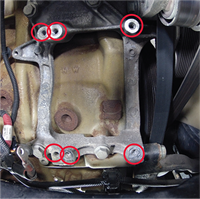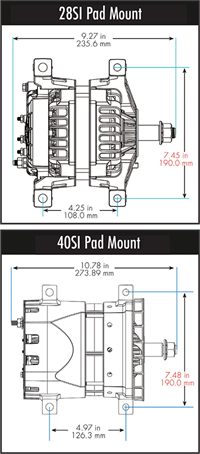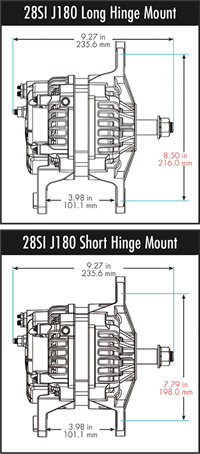There are many different alternator mounting positions and belt configurations on heavy duty diesel engines today. With innovations in brushless technology, higher output alternators and upgraded electrical components, companies now manufacture alternators in various sizes.
When replacing or upgrading your alternator, you’ll need to differentiate between the different sizes and mounting configurations to ensure the smoothest installation.
 Pad Mount
Pad Mount
Heavy duty diesel engines have six holes drilled and tapped into the block of the engine or alternator mounting bracket to accommodate both long mounting pads and short mounting pads. This is standard in on- and off-highway applications. So whether you are replacing a long-pad mount style to a short-pad mount style, or vice versa, the alternators will interchange on the application.
To replace an alternator with a different pad length or mounting hole centerline, follow these steps:
STEP 1 | Identify the mounting hole locations. In most cases, the tapped holes will be visible. On certain applications, a bolt will be inserted into the hole to keep out debris and protect the hole and threads from becoming damaged. In this case, the bolts are not securing anything and can be removed for the installation of the new alternator.

STEP 2 | Determine which holes to use. The pad mount holes closest to the drive belt side always will be used on the top and bottom of the mount. The back pad mount is where the double holes are drilled and tapped for the long pad and short pad.
STEP 3 | Compare alternator sizes. The hole configurations are typically different when upgrading from brush type alternators, such as the Delco Remy 22SI™, 24SI™ or 28SI™, to high output brushless ones, such as the Delco Remy 35SI™, 36SI™, 38SI™, 40SI™ or 55SI™. That's because the case and mounting pads on brushless alternators are much larger. The brush type alternators have a mounting spread of 108mm or 4.25 inches. The brushless type alternators have a mounting spread of 126mm or 4.97 inches. Some competitive type alternators also have the longer 4.97-inch pad mount span.
J180 Mount
The J180 mount is available in two mounting size dimensions: a long hinge and a short hinge.
Replacing with Adjustable Slide Bracket Mount
If the engine alternator mounting bracket is an adjustable slide bracket mount, both the short hinge and the long hinge will fit in the bracket without modifications to the mounting.
There are two reasons for an adjustable slide mount:
- The alternator is the main point for adjusting the drive belt tension and can be slid looser or tighter to adjust the drive belt tension.
- Different size alternator mounting spreads from various manufacturers can be used.

Replacing with Fixed Mount
You also can replace an alternator using a fixed or non-adjustable mount. If the J180 mount is a fixed position mount, then only that size mounting can be used when installing a new alternator. Delco Remy alternators are available in both long-hinge and short-hinge style mounts.
It’s important to know the size difference in the short and long mounts. For example, the short hinge style of the Delco Remy alternator has a mounting spread of 7.79 inches between the top and bottom front mounting holes. Some competitive units have a mounting spread of 8.50 inches between the top and bottom front mounting holes.
If the current alternator you are replacing specifically calls for one mount type or the other, and the Delco Remy alternator you are replacing it with is a longer or shorter hinge mount, call Technical Assistance at 800-372-0222 to obtain the correct part number for the mounting you require.
Watch our
Tech Tip video about upgrading alternators with different mounting sizes and configurations.